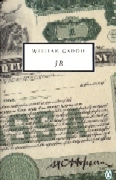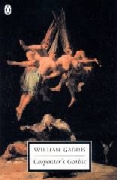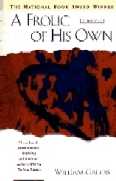 The Recognitions (1955) is an immense work filled with literary,
historical, mythological and religious allusions. The novel follows more
than 50 characters over a 30-year period as their paths cross in New York,
New England, Paris, Italy and Spain. While the novel did not gain much
popular or critical attention at first (it was generally regarded as long
and difficult), it gradually attained an almost “cult” following
as well as critical respect. It was rediscovered years later as having a
unique and primary place in contemporary literature.
The Recognitions (1955) is an immense work filled with literary,
historical, mythological and religious allusions. The novel follows more
than 50 characters over a 30-year period as their paths cross in New York,
New England, Paris, Italy and Spain. While the novel did not gain much
popular or critical attention at first (it was generally regarded as long
and difficult), it gradually attained an almost “cult” following
as well as critical respect. It was rediscovered years later as having a
unique and primary place in contemporary literature.—Richard Toney, San Francisco Review of Books
 JR (1975), at 726 pages, is a huge satire of corporate America and its
obsession with money. JR is an account of the corporate exploits of
an 11-year-old boy who amasses, through cunning and deceit, an enormous
financial empire. The novel is composed almost entirely of dialogue that
reads like a transcription of actual conversations, with ungrammatical,
incomplete sentences and constant interruptions by other characters.
JR won the National Book Award for best fiction of the year.
JR (1975), at 726 pages, is a huge satire of corporate America and its
obsession with money. JR is an account of the corporate exploits of
an 11-year-old boy who amasses, through cunning and deceit, an enormous
financial empire. The novel is composed almost entirely of dialogue that
reads like a transcription of actual conversations, with ungrammatical,
incomplete sentences and constant interruptions by other characters.
JR won the National Book Award for best fiction of the year.—George Stade, The New York Times Book Review
 Carpenter’s Gothic (1985) takes place over a month’s time
in a Victorian house in a small Hudson River Valley town. Carpenter’s
Gothic presents its author’s most characteristic themes and techniques
with flair and economy.
Carpenter’s Gothic (1985) takes place over a month’s time
in a Victorian house in a small Hudson River Valley town. Carpenter’s
Gothic presents its author’s most characteristic themes and techniques
with flair and economy.—Cynthia Ozick, The New York Times Book Review
 A Frolic of His Own (1994) was rated “One of the Worst Novels of
1994” by Entertainment Weekley. EW placed the book
alongside Bret Easton Ellis’ The Informers and Elizabeth
Wurtzel’s Prozac Nation with the judges (Erica K. Cardozo and
Ken Tucker) claiming “William Gaddis’ overblown novel is an
unworthy successor to good Gaddis works like JR and The
Recognitions. One suspects a case of a novelist succumbing to his
hype.” Not everyone agreed with EW’s assessment of the
novel, however: It won Gaddis his second National Book Award.
A Frolic of His Own (1994) was rated “One of the Worst Novels of
1994” by Entertainment Weekley. EW placed the book
alongside Bret Easton Ellis’ The Informers and Elizabeth
Wurtzel’s Prozac Nation with the judges (Erica K. Cardozo and
Ken Tucker) claiming “William Gaddis’ overblown novel is an
unworthy successor to good Gaddis works like JR and The
Recognitions. One suspects a case of a novelist succumbing to his
hype.” Not everyone agreed with EW’s assessment of the
novel, however: It won Gaddis his second National Book Award.